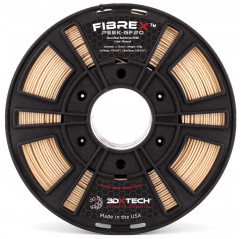Package contains: 1 x FIBREX PEEK+GF20 - Natural / 1.75mm - 3DXTech
FibreX? PEEK+GF20 (PolyEtherEtherKetone) is one of the highest performing polymers in the world. In fact, it is one of the highest performing plastics ever invented. Now 20% glass fiber reinforced, PEEK+GF20 has exceptional mechanical, thermal and chemical resistance properties along with low warpage, increased stiffness and improved dimensional stability. PEEK+G20 is a material of choice in some of the most demanding applications where failure is not an option.
Benefits of PEEK+GF20 include:
Inherently flame resistant and self-extinguishing
Long-term hydrolytic stability even above 250 °C
Exceptional resistance to a wide range of chemicals, including automotive fluids, fully halogenated hydrocarbons, alcohols and aqueous solutions
Low smoke and toxic gas emissions
Excellent dimensional stability with low thermal creep, low and uniform coefficient of thermal expansion, giving PEEK highly reproducible part-to-part dimensions
High thermal properties with a Tg of 143°C, CUT of 260°C and Tm of 343
Typical PEEK+GF20 applications include:
Gaskets, gears, bushings, bearings, pump and compressor components
Industries served: automotive, aerospace, defense, semiconductor, oil and gas
Filament specifications:
1.75 mm and 2.85 mm +/- 0.05 mm diameter
Recommended print settings:
Extruder: 375-410°C
Bed temperature: 130-145°C
Nozzle: we strongly recommend a hardened steel nozzle with a minimum diameter of 0.4 mm for abrasive materials such as this
Other: the ideal layer height is 60% of the nozzle diameter. We do not recommend printing layers smaller than 0.2 mm with abrasive filaments
Bed Prep: Nano Polymer Adhesive gives us the best results
Heated Chamber: recommended, a wrap helps reduce warpage and improves printing success. 70-140°C if possible
Media: The high temperature media ThermaX? HTS is designed to work with complex, high-temperature materials just like this
Drying instructions: 120°C for 4 hours
Abrasive material
This material is particularly abrasive among 3D printing filaments. Users may find that standard brass nozzles are chewed up very quickly compared to standard wear. If worn, the nozzle diameter will expand inconsistently and the printer will encounter extrusion problems.
For this reason, we strongly recommend printing this material through a hardened steel nozzle rather than a softer metal. Hardened steel nozzles can often be inexpensive and easy to install depending on the printer manufacturer's instructions.













